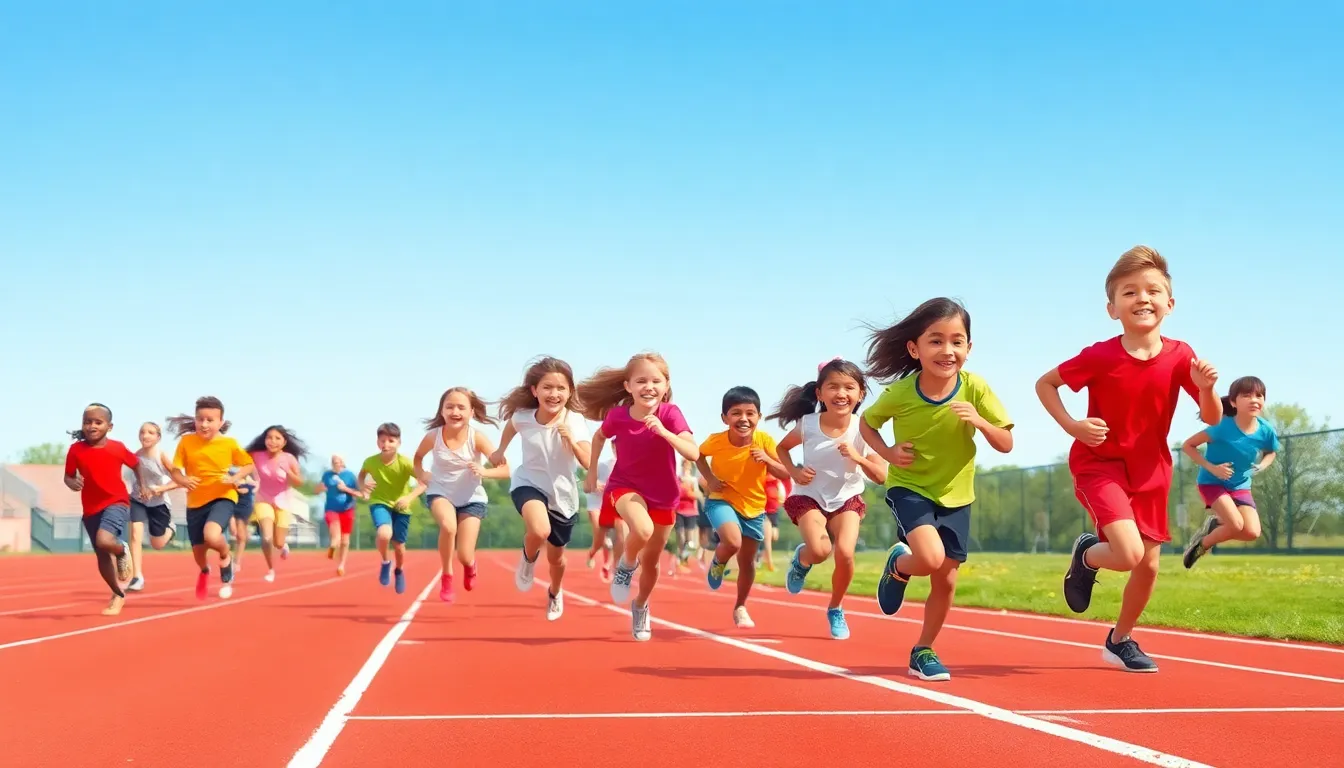Table of Contents
ToggleWhen it comes to getting kids moving, athletics events are the secret sauce for fun and fitness. Imagine a world where kids trade video games for track shoes and discover the thrill of racing against their friends. Not only do these events keep them active, but they also teach teamwork, discipline, and the joy of healthy competition.
Overview of Athletics Events for Kids
Athletics events encompass various activities that engage children in physical fitness while promoting enjoyment. Track and field events, which include running, jumping, and throwing, serve as the foundation for many sports programs. Children often participate in sprints, hurdles, long jumps, and shot put, which help develop their coordination and strength.
Something noteworthy is the focus on age-appropriate competitions that foster skill development. Many local communities organize fun runs, mini-marathons, and school-based meets. These events encourage children to push themselves while creating a supportive environment.
Life lessons learned through athletics events contribute significantly to children’s overall development. Teamwork is enhanced when kids participate in relay races, where collaboration among peers proves essential for success. Discipline becomes evident as athletes practice regularly, preparing for upcoming competitions.
There’s also a social aspect that enhances children’s experience in athletics events. Friendships form during training sessions and competitions, fostering camaraderie among participants. Events often include a mix of challenges, ensuring that all children, regardless of skill level, find activities that interest them.
Participation in athletics events brings health benefits, including improved cardiovascular fitness and enhanced motor skills. Overall, athletics events not only keep kids active but also create an environment that nurtures personal growth and development.
Benefits of Participating in Athletics

Participating in athletics offers children numerous advantages that support their overall well-being and development.
Physical Health Benefits
Improved cardiovascular health results from regular engagement in athletic events. Increased stamina enhances a child’s ability to participate in daily activities. Strengthening muscles occurs through various track and field exercises. Enhanced motor skills, including coordination and agility, develop as children practice their techniques. Children also maintain a healthy weight as athletic participation encourages physical activity over sedentary behaviors. Regular participation significantly contributes to lifelong habits of fitness.
Mental and Emotional Benefits
Boosted confidence accompanies children who successfully achieve personal goals in athletics. Improved focus results from the discipline required to train and compete. Emotional resilience fosters as children learn to handle both victories and defeats. The social skills children acquire during team events enhance their ability to communicate and collaborate with peers. Enjoyment of physical activity grows when children experience the camaraderie of participating in athletic events. Stronger stress management skills develop through commitment and practice.
Popular Athletics Events for Kids
Athletics events for kids provide a fun and engaging way for young athletes to develop their skills. The following categories highlight key events kids can participate in.
Track Events
Track events feature various running competitions designed for children. Sprints, often 100 meters and 200 meters, challenge speed and explosiveness. Middle-distance events, like the 400 meters and 800 meters, focus on endurance and pacing. Relay races, typically 4×100 meter and 4×400 meter, encourage teamwork and relay baton exchanges. Fun runs, like 1K or 2K, introduce kids to racing in a less competitive atmosphere. These events not only promote cardiovascular health but also help children build confidence and camaraderie.
Field Events
Field events encompass jumping and throwing disciplines that enhance athletic versatility. Long jump and triple jump tests horizontal speed and jumping technique. High jump encourages kids to develop strength and agility through upward leaps. Throwing events, such as shot put and javelin, focus on technique and power. These activities promote coordination and muscle development. Each event challenges kids in different ways, fostering skill growth while ensuring enjoyment and participation.
How to Get Kids Involved in Athletics
Involving kids in athletics requires guidance and accessible opportunities. Parents and guardians play a crucial role in facilitating this engagement.
Finding Local Programs
Exploring local sports programs helps identify suitable opportunities for children. Many communities offer organized activities through schools, recreation centers, and sports clubs. These programs often cater to various age groups, ensuring age-appropriate experiences. Searching online for “youth athletics near me” provides a starting point for discovering options. Involving peers encourages kids to join together, enhancing motivation and enjoyment. Local events may also feature fun runs or competitive meets, fostering skill development and camaraderie.
Importance of Coaching and Support
Effective coaching enhances children’s experiences in athletics. Trained coaches provide essential guidance, helping kids develop skills in a supportive environment. Positive reinforcement instills confidence and encourages perseverance. Additionally, parental support is vital, as it creates a nurturing atmosphere around training and competitions. Parents attending events and cheering from the sidelines inspires kids to excel. Collaboration between coaches and parents fosters a community focused on each child’s growth and well-being. Establishing strong communication channels ensures that everyone remains aligned in promoting a healthy athletic experience.
Safety Considerations in Youth Athletics
Safety plays a crucial role in youth athletics. Coaches must implement proper training regimens to prevent injuries. Age-appropriate activities and competitions minimize risks associated with overexertion. Regular medical check-ups ensure children are physically prepared to participate.
Athletic facilities should maintain safe environments. Parents should inspect the fields and equipment before events. Proper footwear and attire enhance safety by providing adequate support. Hydration stations need to be readily available to prevent dehydration during activities.
Communication is essential for parents, coaches, and athletes. Establishing routine safety briefings ensures everyone stays informed. Reporting any injuries immediately allows for prompt medical attention. Identifying and addressing potential hazards helps maintain a safe environment.
Supervisors should always monitor practices and competitions. Adequate adult supervision ensures athletes remain safe throughout events. Pairing athletes of similar skill levels fosters a more balanced and secure competitive atmosphere. Organizing smaller groups can help manage safety more effectively.
Emergency protocols must be in place for all events. First-aid kits should be easily accessible during practices and competitions. Coaches should be trained in basic first aid techniques and CPR. Establishing clear contact procedures can enhance response times during emergencies.
Encouraging children to listen to their bodies promotes a culture of safety. Educating young athletes about injury signs reduces long-term health risks. Parents should support children in understanding limits, fostering resilience and self-awareness. Prioritizing safety ensures a positive experience that enhances both enjoyment and skill development.
Athletics events for kids offer a fantastic way to promote physical fitness and personal growth. By participating in these activities, children not only improve their health but also develop essential life skills. The excitement of competition and the joy of teamwork create lasting memories and friendships.
Parents and coaches play a pivotal role in encouraging participation and ensuring a safe environment. By fostering a supportive atmosphere, they help children thrive both athletically and socially. Engaging in athletics sets the foundation for a lifelong appreciation of fitness and well-being. As kids embrace these experiences, they cultivate resilience and confidence that will benefit them in all areas of life.










